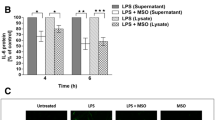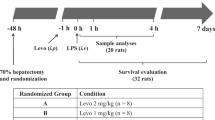Abstract
Culturing hepatocytes with a combination of LPS, TNF-α, IL-1β and IFN-γ resulted in an inhibition of glucose output from glycogen and prevented the repletion of glycogen in freshly cultured cells. The reduced glycogen mobilisation correlated with the lower cell glycogen content and reduced rate of glycogen synthesis from [U-14C]glucose rather than alterations in either total phosphorylase or phosphorylase a activity. There was no change in the percentage of glycogen exported as glucose nor the production of lactate plus pyruvate indicating that redistribution of the Gluc-6-P cannot explain the failure of the liver to export glucose. Although changes in glycogen mobilisation correlated with NO production, inhibition of NO synthase by inclusion of L-NMMA in the culture medium failed to prevent the inhibition of either glycogen accumulation or mobilisation by the proinflammatory cytokines, precluding the involvement of NO in this response. LPS plus cytokine treatment had no effect on total glycogen synthase activity although the activity ratio was lowered, indicative of increased phosphorylation. The inhibition of glycogen synthesis correlated with a fall in the intracellular concentrations of Gluc-6-P and UDP-glucose and in the absence of measured changes in kinase activity, it is suggested that the fall in Gluc-6-P reduces both substrate supply and glycogen synthase phosphatase activity. The fall in Gluc-6-P coincided with a reduction in total glucokinase and hexokinase activity within the cells, but no significant change in either the translocation of glucokinase or glucose-6-phosphatase activity. This demonstrates direct cytokine effects on glycogen metabolism independent of changes in glucoregulatory hormones.

Similar content being viewed by others
Abbreviations
- Gluc-6-P:
-
Glucose-6-phosphate
- LPS:
-
Lipopolysaccharide
- TNF-α:
-
Tumour necrosis factor-α
- IL-1β:
-
Interleukin-1β
- IFN-γ:
-
Interferon-γ
- L-NMMA:
-
L-Nω-monomethyl-l-arginine
References
Kilbourn R (1997) Nitric oxide and shock. Dis Mon 43:281–348
Titheradge MA (1999) Nitric oxide in septic shock. Biochim Biophys Acta 1411:437–455
Williamson JR, Refino C, LaNoue K (1970) Effects of E. coli lipopolysaccharide B treatment of rats on gluconeogenesis. In: Porter T, Knight J (eds) CIBA foundation symposium on energy metabolism in trauma. Churchill, London, pp. 145–154
Wolfe RR, Burke JF (1978) Glucose and lactate metabolism in experimental septic shock. Am J Physiol 4:R219–R227
Knowles RG, Beevers SJ, Pogson CI (1986) The roles of glucagon, insulin and glucocorticoid hormones in the effects of sublethal doses of endotoxin on glucose hoeostasis in rats. Biochem Pharmacol 35:4043–4048
Knowles RG, McCabe JP, Beevers SJ et al (1987) The characteristics and site of inhibition of gluconeogenesis in rat liver cells by bacterial endotoxin. Biochem J 242:721–728
Ceppi ED, Knowles RG, Carpenter KM, Titheradge MA (1992) Effect of treatment in vivo of rats with bacterial endotoxin on fructose 2,6-bisphosphate metabolism and L-pyruvate kinase activity and flux in isolated liver cells. Biochem J 284:761–766
Liu MS, Kang GF (1987) Liver glycogen metabolism in endotoxin shock. 1. Endotoxin administration decreases glycogen synthase activities in dog livers. Biochem Med Metab Biol 37:61–72
Casteleijn E, Kuiper J, Van Rooij HC et al (1988) Endotoxin stimulates glycogenolysis in the liver by means of intercellular communication. J Biol Chem 263:6953–6955
Bagby GJ, Lang CH, Hargrove DM et al (1988) Glucose kinetics in rats infused with endotoxin-induced monokines or tumor necrosis factor. Circ Shock 24:111–121
Hill M, McCallum R (1991) Altered transcriptional regulation of phosphoenolpyruvate carboxykinase in rats following endotoxin treatment. J Clin Invest. 88:811–816
Ardawi MS, Ashy AA, Jamal YS et al (1989) Metabolic control of hepatic gluconeogenesis in response to sepsis. J Lab Clin Med 114:579–586
Maitra SR, Gestring ML, ElMaghrabi MR et al (1999) Endotoxin-induced alterations in hepatic glucose-6-phosphatase activity and gene expression. Mol Cell Biochem 196:79–83
Giger O, McCallum RE (1976) Reponse of mouse liver glycogen cycle enzymes to endotoxin treatment. Am J Physiol 231:1285–1289
Buday AZ, Lang CH, Bagby GJ et al (1986) Glycogen-synthase and phosphorylase activities during glycogen repletion in endotoxemic rats. Circ Shock 19:149–163
Liu MS, Kang GF (1987) Liver-glycogen metabolism in endotoxin-shock 2. Endotoxin administration increases glycogen-phosphorylase activities in dog livers. Biochem Med Metab Biol 37:73–80
Hamosh M, Shapiro B (1960) The mechanism of glycogenolytic action of endotoxin. Br J Exp Pathol 41:372–380
Akira S, Hirano T, Taga T, Kishimoto T (1990) Biology of multifunctional cytokines: IL 6 and related molecules (Il 1 and TNF). FASEB J 4:2860–2867
Flores EA, Istfan N, Pomposelli JJ et al (1990) Effect of interleukin-1 and tumour necrosis factor/cachectin on glucose turnover in the rat. Metabolism 39:738–743
Chajek-Shaul T, Barash V, Weidenfeld J et al (1990) Lethal hypoglycemia and hypothermia induced by administration of low doses of tumor necrosis factor to adrenalectomized rats. Metabolism 39:242–250
Metzger S, Begleibter N, Barash V et al (1997) Tumor necrosis factor inhibits the transcriptional rate of glucose-6- phosphatase in vivo and in vitro. Metabolism 46:579–583
Metzger S, Goldschmidt N, Barash V (1997) Interleukin-6 secretion in mice is associated with reduced glucose-6-phosphatase and liver glycogen levels. Am J Physiol 36:E262–E267
Ceppi ED, Smith FS, Titheradge MA (1996) Effect of multiple cytokines plus bacterial endotoxin on glucose and nitric oxide production by cultured hepatocytes. Biochem J 317:503–507
Ceppi ED, Titheradge MA (1998) The importance of nitric oxide in the cytokine-induced inhibition of glucose formation by cultured hepatocytes incubated with insulin, dexamethasone and glucagon. Arch Biochem Biophys 349:167–174
Agius L, Peak M, Alberti KG (1990) Regulation of glycogen synthesis from glucose and gluconeogenic precursors by insulin in periportal and perivenous rat hepatocytes. Biochem J 266:91–102
Alegre M, Ciudad CJ, Fillat C et al (1988) Determination of glucose-6-phosphatase activity using the glucose dehydrogenase-coupled reaction. Anal Biochem 173:185–189
Vandercammen A, Van Schaftingen E (1993) Species and tissue distribution of the regulatory protein of glucokinase. Biochem J 294:551–556
Agius L, Peak M, Newgard CB et al (1996) Evidence for a role of glucose-induced translocation of glucokinase in the control of hepatic glycogen synthesis. J Biol Chem 271:30479–30486
Hue L, Bontemps F, Hers HG (1975) The effect of glucose and potassium ions on the conversion of the two forms of glycogen phosphorylase and of glycogen synthetase in isolated rat liver preparations. Biochem J 152:105–114
Uhing RJ, Janski AM, Graves DJ (1979) The effect of solvents on nucleotide regulation of glycogen phosphorylase. J Biol Chem 254:3166–3169
Dopere F, Vanstapel F, Stalmans W (1980) Glycogen-synthase phosphatase-activity in rat-liver – 2 protein-components and their requirement for the activation of different types of substrate. Eur J Biochem 104:137–146
Welsh GI, Patel JC, Proud CG (1997) Peptide substrates suitable for assaying glycogen synthase kinase-3 in crude cell extracts. Anal Biochem 244:16–21
Smith FS, Ceppi ED, Titheradge MA (1997) Inhibition of cytokine-induced inducible nitric oxide synthase expression by glucagon and cAMP in cultured hepatocytes. Biochem J 326:187–192
Smith PK, Krohn RI, Hermanson GT et al (1985) Measurement of protein using bicinchoninic acid. Anal Biochem 150:76–85
Curran RD, Billiar TR, Stuehr DJ et al (1990) Multiple cytokines are required to induce hepatocyte nitric oxide production and inhibit total protein synthesis. Ann Surg 212:462–469
Horton RA, Ceppi ED, Knowles RG et al (1994) Inhibition of hepatic gluconeogenesis by nitric oxide: a comparison with endotoxic shock. Biochem J 299:735–739
Sprangers F, Sauerwein HP, Romijn JA (1998) Nitric oxide inhibits glycogen synthesis in isolated rat hepatocytes. Biochem J 330:1045–1049
Watford M (1988) What is the metabolic-fate of dietary glucose. Trends Biochem Sci 13:329–330
Tosh D, Beresford G, Agius L (1994) Glycogen-synthesis from glucose by direct and indirect pathways in hepatocyte cultures from different nutritional states. Biochim Biophys Acta 1224:205–212
Agius L, Tosh D, Peak M (1993) The contribution of pyruvate cycling to loss of [6–3H]glucose during conversion of glucose to glycogen in hepatocytes: effects of insulin, glucose and acinar origin of hepatocytes. Biochem J 289:255–262
Nordlie RC, Bode AM, Foster JD (1993) Recent advances in hepatic glucose 6-phosphatase regulation and function. Proc Soc Exp Biol Med 203:274–285
Tosh D, Agius L (1995) Lactate and pyruvate stimulate the conversion of glucose to glycogen In hepatocytes by a mechanism that does not involve gluconeogenic flux. Biochim Biophys Acta 1268:165–170
Agius L, Chowdhury MH, Davis SN et al (1986) Regulation of ketogenesis, gluconeogenesis, and glycogen synthesis by insulin and proinsulin in rat hepatocyte monolayer cultures. Diabetes 35:1286–1293
Arnold J, Hamer MJ, Irving M (1991) Hepatic phosphofructokinase-1 activity and fructose 2,6-bisphosphate levels in patients with abdominal sepsis. Clin Sci 80:213–217
Horton RA, Knowles RG, Titheradge MA (1994) Endotoxin causes reciprocal changes in hepatic nitric oxide synthesis, gluconeogenesis, and flux through phosphoenolpyruvate carboxykinase. Biochem Biophys Res Commun 204:659–665
Stadler J, Billiar TR, Curran RD (1991) Effect of exogenous and endogenous nitric oxide on mitochondrial respiration of rat hepatocytes. Am J Physiol 260:C910–C916
Brown GC (2001) Regulation of mitochondrial respiration by nitric oxide inhibition of cytochrome c oxidase. Biochim Biophys Acta 1504:46–57
Vaartjes WJ, de Haas CG, Houweling M (1990) Acute effects of interleukin 1 alpha and 6 on intermediary metabolism in freshly isolated rat hepatocytes. Biochem Biophys Res Commun 169:623–628
Aiston S, Hampson L, Gomez-Foix AM et al (2001) Hepatic glycogen synthesis is highly sensitive to phosphorylase activity – evidence from metabolic control analysis. J Biol Chem 276:23858–23866
Bollen M, Keppens S, Stalmans W (1998) Specific features of glycogen metabolism in the liver. Biochem J 336:19–31
Solling H (1979) Studies on the allosteric properties of glycogen synthase-I. Eur J Biochem 94:231–242
Cao YJ, Skurat AV, DePaoli-Roach AA et al (1993) Initiation of glycogen-synthesis – control of glycogenin by glycogen-phosphorylase. J Biol Chem 268:21717–21721
Bitensky MW, Gorman RE, Thomas L (1971) Selective stimulation of epinephrine-responsive adenyl cyclase in mice by endotoxin. Proc Soc Exp Biol Med 138:773–775
Deaciuc IV, Spitzer JA (1986) Rat liver free cytosolic Ca2+ and glycogen phosphorylase in endotoxicosis and sepsis. Am J Physiol 251:R984–R995
Halse R, Fryer LGD, McCormack JG et al (2003) Regulation of glycogen synthase by glucose and glycogen – a possible role for AMP-activated protein kinase. Diabetes 52:9–15
Pencek RR, Shearer J, Camacho RC et al (2005) 5-Aminoimidazole-4-carboxamide-1-beta-D-ribofuranoside causes acute hepatic insulin resistance in vivo. Diabetes 54:355–360
Vary TC, Deiter G, Kimball SR (2002) Phosphorylation of eukaryotic initiation factor eIF2B epsilon in skeletal muscle during sepsis. Am J Physiol 283:E1032–E1039
VillarPalasi C, Guinovart JJ (1997) The role of glucose 6-phosphate in the control of glycogen synthase. FASEB J 11:544–558
Mori E, Hasebe M, Kobayashi K et al (1987) Alterations in metabolite levels in carbohydrate and energy metabolism of rat in hemorrhagic shock and sepsis. Metabolism 36:14–20
Ferrer JC, Favre C, Gomis RR et al (2003) Control of glycogen deposition. FEBS Lett 546:127–132
Fernandez-Novell JM, Arino J, Vilaro S et al (1992) Role of glucose-6-phosphate in the translocation of glycogen- synthase in rat hepatocytes. Biochem J 288:497–501
Acknowledgements
This work wassupported by Grant 060451 from the Wellcome Trust. JW would like to thank the University of Sussex for a Graduate Teaching Assistanship.
Author information
Authors and Affiliations
Corresponding author
Rights and permissions
About this article
Cite this article
Wallington, J., Ning, J. & Titheradge, M.A. The control of hepatic glycogen metabolism in an in vitro model of sepsis. Mol Cell Biochem 308, 183–192 (2008). https://doi.org/10.1007/s11010-007-9627-y
Received:
Accepted:
Published:
Issue Date:
DOI: https://doi.org/10.1007/s11010-007-9627-y




